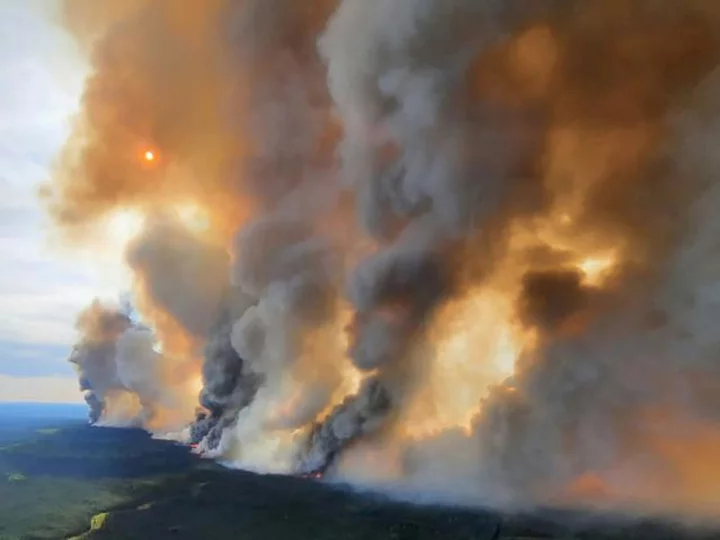Raging wildfires in Canada have already scorched about 15 times the normal burned area for this time of the year: nearly 11 million acres — more than double the size of New Jersey — with more than 2 million acres concentrated in Quebec alone.
Canada's fire season is only just beginning, and officials there warned this week it would continue to be severe through the summer. If it follows the pattern of a normal year, it will peak in the hotter months of July and August.
But this is anything but a normal year.
"I'm not a big fan of this word, but this is unprecedented," said Michael Flannigan, professor of wildland fire at Thompson Rivers University in British Columbia. "It started the year off with a very active, extreme and historic fire season. For much of Canada, our fire season is still very much ahead of us."
Flannigan told CNN this year's wildfires came "extremely early," especially for the country's Northwest Territories, where 22 fires have burned nearly a million acres so far this year alone. That's more than 60 times more than average for the region.
Human-caused climate change has exacerbated the hot and dry conditions that allow wildfires to ignite and grow. Over the past few years, some of these fires have also exhibited extreme fire behavior, including alarming rotational patterns, creating their own clouds and wafting smoke across the continent.
"We're seeing more and more of these," Flannigan said. "And that's the sign that our fires are getting more intense."
It's not just Canada. Experts told CNN parts of the United States, which have been engulfed in wildfire smoke this week, may also see extreme fire conditions this year, beyond the typically fire-prone Western states.
"What concerns me is we're starting to see drought conditions form in the Northeast and mid-Atlantic, and it's not uncommon once drought forms to start spreading," Mark Zondlo, an atmospheric chemist and professor of civil and environmental engineering at Princeton University, told CNN. "And the question is — what is it going to take to stop this pattern?"
'The stage was set'
Three ingredients must be present for these large fires to occur, Flannigan said: fuel such as grass, shrubs and trees; an ignition source, whether it's sparked by humans or lightning; and lastly, hot, dry and windy weather.
All three ingredients were present across much of Canada this year, he added.
"The stage was set for this active fire season to occur," Flannigan said, noting "all indications" would suggest fires will get worse this summer.
Canada's temperatures in May were off the charts and well above normal for the month. Nearly the entire country saw above-average temperatures, with "numerous high-temperature records broken," the Copernicus Climate Change Service reported this week.
In addition to the extreme temperatures, below-average rainfall in the spring left much of the country drier than normal, particularly for parts of Alberta and Saskatchewan, both of which saw an unprecedented early and active start to the fire season.
"It's kind of a perfect storm," Zondlo said.
What it could mean for the US this year
What's happening in Canada could be a sign of what's to come in the United States this year.
Experts say it is difficult to tell how severe California's wildfire season will be after good winter precipitation, the National Interagency Fire Center is forecasting an active fire season for Washington and Oregon.
The northern parts of the Midwest and Northeast could also see an active fire summer. Zondlo worries Canada's exceptional start to the fire season may indicate similar potential in the Eastern US.
"Drought is starting to form here in the Northeast, mid-Atlantic and parts of the Midwest, and suddenly you start worrying — are we looking at expanding this intense drought, and so what are the risk of wildfires associated with that?" he said. "We just had wildfires in Nova Scotia. I know they occur, but not (usually) at the scale that we saw two weeks ago."
A burning issue
For Brendan Rogers, associate scientist at the Woodwell Climate Research Center, one of the most concerning issues is the wildfires' effect on Canada's boreal forests. These forests are the world's largest biome and occupy vast tracts of the Northern Hemisphere, including North America.
The boreal forests are major carbon sinks, storing roughly 30% to 40% of all land-based carbon in the world, most of it in the soil. They play a vital role in holding back the climate crisis, which makes the threats they face all the more concerning.
The forests' colder temperatures prevent dead biomass, such as leaves and wood, from breaking down, which means huge amounts of carbon have been stored and accumulated for thousands of years deep in the permafrost.
"The problem is really, as we warm, those microbes start to wake up more, they started to eat that carbon, and we also get more disturbances, especially like fire," Rogers said. "And fire, of course, is a part of these systems. It always has been but we're seeing an intensification of the fire regime."
It's a constant feedback loop. As climate change fuels more fires across the continent, it releases the same planet-heating carbon and methane that is causing the climate crisis, the effects of which are felt everywhere.
Flannigan said he modeled this situation 20 years ago in a study that suggested the Eastern US and Canada could be much more flammable by midcentury than it was back then.
But with the speed at which the climate is changing, he admitted, "it may be happening quicker than we thought."
"As we continue to warm, expect to see more episodes of fires," he said. "Not every year is going to be bad, but overall, the new reality is we have to learn to live with fire and smoke."









